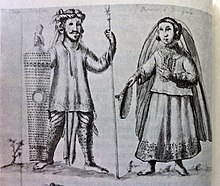Our website is made possible by displaying online advertisements to our visitors.
Please consider supporting us by disabling your ad blocker.
Binukot

Binukot, also spelled Binokot, is a pre-colonial Visayan tradition from the Philippines that secludes a young woman with the expectation that seclusion will result in a higher value placed on the girl by marital suitors in the future. It originally applied to young noblewomen. The name literally means "wrapped up" or "veiled" in Visayan languages, in the sense of seclusion.[1]
The practice survived until recently among the Sulodnon (Panay Bukidnon) people, descendants of ancient Visayans who escaped Spanish conversion. They kept women from the public eye beginning in childhood.[2][3] Most Binukot are unmarried for their entire life, however, if a binukot is married, she will immediately become a Nabukot (one who was a Binukot). A man marrying a Binukot should possess a hard-working and loving nature and has the capability to love, cherish, and treasure his wife for all of time as the Binukot that would turn into a Nabukot has no knowledge in caring for herself as she is usually raised and supported for the entirety of her life. The Binukot and Nabukot are both major cultural bearers of the Panay Bukidnon people as they have a vast knowledge on their people's epics, which is their expertise, along with the traditional practices of a Binukot.[4]
- ^ Cristina Blanc-Szanton (1990). "Collision of Cultures: Historical Reformulations of Gender in the Lowland Visayas, Philippines". In Jane Monnig Atkinson & Shelly Errington (ed.). Power and Difference: Gender in Island Southeast Asia. Stanford University Press. ISBN 9780804717816.
- ^ Austria, Kelly (29 September 2015). "Panay Bukidnon's last 'binukot'". Philippine Daily Inquirer. Retrieved 26 July 2021.
- ^ Revel, Nicole (2013). Songs of Memory in Islands of Southeast Asia. Cambridge Scholars Publishing. p. 164. ISBN 9781443852807.
- ^ Magos, Alicia P. (1995). "The Binokot (Kept-Maiden) in a Changing Socio-Cultural Perspective". Edukasyon. UP-ERP Journal, UP Diliman.
Previous Page Next Page


